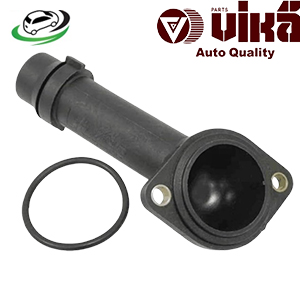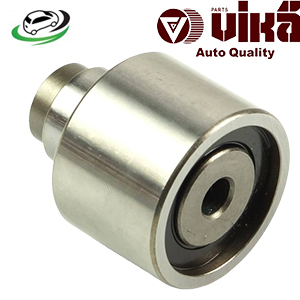-11%
Get AUDI A3 (8P1)/ A3 Sportback / VW Passat B6 (3C2)/ Jetta III (1K2)/ Golf V (1K1)/ Touran (1T1 1T2) Timing Belt Idler Roller 038109244J
The timing belt idler roller, often referred to simply as the idler pulley, plays a crucial role in the functioning of an internal combustion engine. It is a key component of the timing belt system, helping to maintain proper tension and alignment of the timing belt. This guide explores the functions, construction, working principles, applications, advantages, and maintenance of timing belt idler rollers.
1. What is a Timing Belt Idler Roller?
The timing belt idler roller is a cylindrical component that serves as a guide for the timing belt in an engine. Its primary purpose is to maintain the correct tension and alignment of the timing belt, ensuring smooth operation of the engine’s camshaft and crankshaft. The idler roller helps prevent the belt from slipping off the pulleys, which could lead to serious engine damage.
Key Functions of the Timing Belt Idler Roller:
- Belt Tension Maintenance: Ensures the timing belt remains taut, allowing for precise synchronization between the crankshaft and camshaft.
- Belt Alignment: Guides the timing belt, ensuring it runs in alignment with the pulleys to prevent wear and tear.
- Vibration Dampening: Absorbs vibrations from the engine, contributing to smoother operation and reducing noise.
- Wear Resistance: Designed to withstand the wear caused by the constant friction between the timing belt and the pulleys.
2. Construction of the Timing Belt Idler Roller
The construction of a timing belt idler roller is designed to ensure durability and efficient performance. Key components include:
1. Roller Body:
- Material: Typically made from high-strength plastic or metal (such as aluminum or steel) for durability and resistance to wear.
- Shape: The cylindrical shape allows for smooth rotation and minimal friction against the timing belt.
2. Bearing:
- Type: Most idler rollers contain an internal bearing, usually sealed or shielded to protect against dirt and contaminants.
- Function: The bearing enables smooth rotation of the roller, reducing friction and wear on the timing belt.
3. Mounting Bracket:
- Attachment: The idler roller is attached to the engine block or a mounting bracket to ensure stability and proper positioning within the timing belt system.
4. Surface Texture:
- Design: The surface of the roller is often textured or grooved to enhance grip on the timing belt and minimize slippage.
3. Working Principle of the Timing Belt Idler Roller
The operation of the timing belt idler roller is relatively straightforward:
- Tensioning the Timing Belt: As the engine operates, the timing belt is driven by the crankshaft. The idler roller maintains tension on the belt, preventing it from slipping or becoming loose.
- Guiding the Timing Belt: The idler roller provides a guiding surface for the timing belt, ensuring that it runs smoothly over the pulleys of the camshaft and crankshaft.
- Reducing Vibration: The idler roller helps absorb vibrations generated by the engine and the timing belt’s movement, contributing to quieter operation and improved performance.
- Facilitating Engine Timing: By keeping the timing belt taut and aligned, the idler roller ensures that the camshaft and crankshaft remain synchronized, allowing for efficient engine operation.
4. Applications of Timing Belt Idler Rollers
Timing belt idler rollers are widely used in various automotive applications, including:
1. Automotive Engines:
- Internal Combustion Engines: Commonly found in gasoline and diesel engines where a timing belt drives the camshaft and crankshaft.
2. Hybrid and Electric Vehicles:
- Engine Management: Although less common in fully electric vehicles, hybrid systems may still utilize timing belts and idler rollers in their internal combustion engine components.
3. Industrial Equipment:
- Machinery: Used in various industrial applications where timing belts are employed for power transmission and synchronization.
5. Advantages of Timing Belt Idler Rollers
The use of timing belt idler rollers offers several advantages, including:
1. Enhanced Engine Performance:
By maintaining proper tension and alignment of the timing belt, idler rollers contribute to better synchronization between the crankshaft and camshaft, leading to improved engine performance.
2. Reduced Wear on Components:
By guiding the timing belt and absorbing vibrations, idler rollers help reduce wear on the timing belt, pulleys, and other related components.
3. Noise Reduction:
Idler rollers dampen vibrations and noise generated by the engine and timing belt, contributing to a quieter operation.
4. Durability and Reliability:
Constructed from high-quality materials, timing belt idler rollers are designed to withstand the harsh operating conditions of an engine, ensuring long-lasting performance.
5. Cost-Effective Maintenance:
Regular inspection and timely replacement of worn idler rollers can prevent costly engine damage, making them a cost-effective component in engine maintenance.
6. Maintenance of Timing Belt Idler Rollers
Proper maintenance of timing belt idler rollers is essential for ensuring optimal engine performance. Here are some key maintenance tips:
1. Regular Inspections:
Inspect the idler roller periodically for signs of wear, such as cracking, fraying, or abnormal noise. Check for proper alignment and tension of the timing belt.
2. Timing Belt Replacement:
Since the idler roller works in conjunction with the timing belt, it is advisable to replace the idler roller whenever the timing belt is replaced. This helps ensure that both components are new and functioning optimally.
3. Listen for Unusual Noises:
Pay attention to any unusual noises coming from the engine compartment, such as squeaking or grinding sounds. These may indicate that the idler roller or the timing belt is worn and needs attention.
4. Keep the Engine Clean:
Ensure that the engine compartment is clean and free of debris that could interfere with the idler roller’s operation. Dirt and contaminants can cause premature wear.
5. Seek Professional Assistance:
If you notice any signs of trouble with the timing belt or idler roller, seek professional diagnostic services to accurately identify and address the issue.
7. Conclusion
The timing belt idler roller is a vital component of the timing belt system, ensuring the proper functioning of internal combustion engines. By maintaining tension and alignment of the timing belt, it plays a critical role in engine performance, efficiency, and longevity. Understanding the functions, construction, working principles, applications, advantages, and maintenance of timing belt idler rollers is essential for vehicle owners and technicians alike. Regular inspection and timely replacement of worn idler rollers can prevent costly engine damage and ensure optimal performance for years to come.
Follow us on Facebook for more parts.




Reviews
Clear filtersThere are no reviews yet.